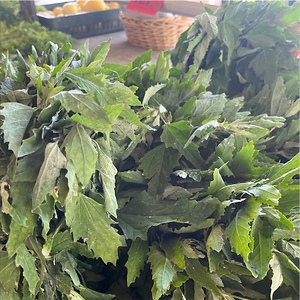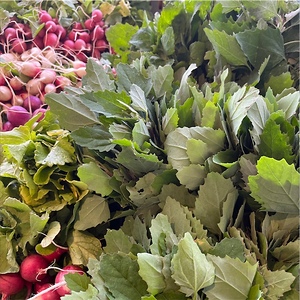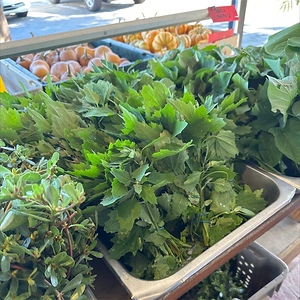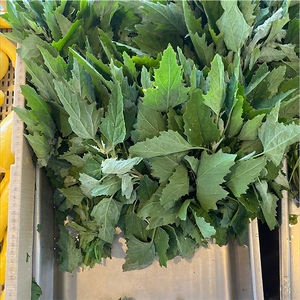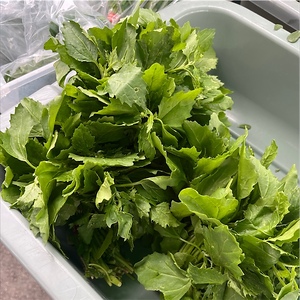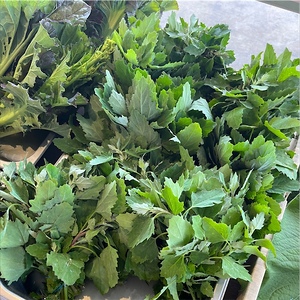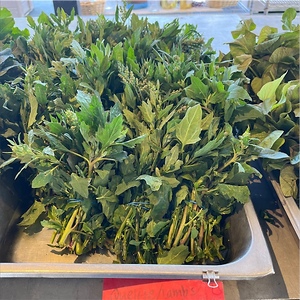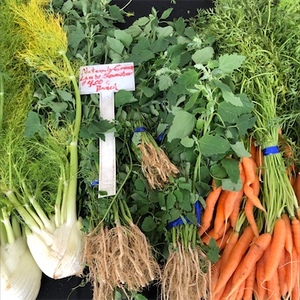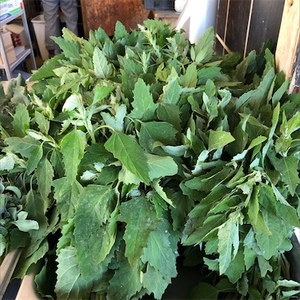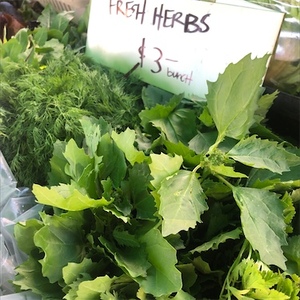


Wild Spinach (Lambsquarter)
Estimated Inventory, bunch : 0
Description/Taste
Wild spinach forms small to medium-sized leaves, averaging 2 to 8 centimeters in diameter and 7 to 15 centimeters in length, that grow in an alternate formation along upright stems. Mature leaves vary in appearance and often showcase triangular, lanceolate, or diamond-like shapes. The leaves are also bright green, sometimes with maroon hues splashed along the edges, depending on the variety, and exhibit prominent veining across the surface with serrated, toothed edges. One of the distinct characteristics of Wild spinach is a soft, velvet-like hair or fuzz found on the leaf's surface. This fuzz-like coating gives the leaves a darker tone on the upper surface and a lighter, silvery-grey shade on the underside. These grey-green hairs are also water resistant due to a waxy coating, and the leaves, in general, are crisp, tender, and fleshy when young. The stems are slender, fibrous, and mostly straight, found in green hues striped with red, purple, and light green shades. In addition to the leaves, Wild spinach produces clusters of tiny pale green flowers on spikes that arise from the center of the plant. The flowers eventually give way to shiny, black-brown seeds encased in a delicate, papery covering in the shape of a star. Each plant can produce 3,000 to 20,000 seeds in a single season, and the seeds can be eaten raw or cooked. Wild spinach seeds have a chewy, faint buckwheat-like flavor, while the leaves and stems have a mild, green, earthy, and vegetal flavor with a subtle minerality.
Seasons/Availability
Wild spinach is available in the spring through fall.
Current Facts
Wild spinach, botanically classified as Chenopodium album, is a wild, edible species belonging to the Amaranthaceae family. The velvety leaves grow on an herbaceous, annual plant reaching up to 1.8 meters in height and are valued worldwide as an ancient, foraged green. Wild spinach is known by many regional names, including Lambsquarters, Fat Hen, Indian Spinach, Pigweed, Bathua and Nathuwa in Hindi, Bethu and Bethe in Nepal, Quelitas in Spanish, Baconweed, and Frost-Blite. The species was also given its botanical name in honor of the leaf's resemblance to the shape of a goose's foot. Chenopodium album was derived from "chen" in Greek, meaning "goose," and "podium," meaning "foot." "Album" means "white," giving the species name the literal translation of White Goosefoot. Despite this direct translation, Wild spinach is only occasionally referred to as Goosefoot, as there are other species within the same botanical family that share the same name. The species also has several different varieties generally labeled under the Wild spinach name, and each variety readily hybridizes with other species within the Amaranthaceae family, making it challenging to distinguish botanically. In the modern day, Wild spinach is a common species found worldwide and is a fast-growing, tenacious plant, able to be continually harvested throughout the season. The species is often considered a weed in some regions, but foragers have looked beyond its aggressive nature and have established the plant as a specialty food source, consuming leaves, stems, flowers, and seeds in an array of culinary preparations.
Nutritional Value
Wild spinach is a source of potassium to balance fluid levels, vitamin C to strengthen the immune system, and magnesium to control optimal nerve functioning. The greens also provide vitamin E to reduce inflammation and protect the cells against free radical damage, folate to build RNA and DNA, fiber to regulate the digestive tract, and other nutrients, including iron, phosphorus, riboflavin, calcium, B vitamins, and manganese. Like common spinach, Wild spinach contains oxalic acid, an organic compound that may be harmful if ingested in large quantities. This acid is reduced when the greens are cooked. In India, Wild spinach is used in Ayurveda, traditional medicine using natural methods to heal and balance the body. The greens are thought to increase digestion, assist with infections, and cleanse the body from toxins and unwanted build-up.
Applications
Wild spinach has a mild, earthy, and green taste suited for lightly cooked preparations. The greens can be eaten raw, tossed into salads, added to smoothies and fresh juices, or used as a garnish, but since the plant contains oxalic acid, it is recommended to consume fresh greens in very small quantities. Wild spinach is more popularly blanched, sauteed, stir-fried, or wilted into dishes to remove most of the oxalic acid. The greens can be blanched and mixed with fresh herbs, boiled as a simple side dish, added to sauces and dips, or tossed into hot pasta and grains to wilt the leaves. Wild spinach can also be added to soups, stews, and curries, stir-fried into vegetables, mixed into bean salads, or steamed and incorporated into casseroles. For faster preparations, Wild spinach can be prepared with the stems still attached to its leaves, as the stems are tender when young. Beyond the leaves, the flowers and seeds are edible. The seeds are traditionally added to bread, muffins, pancakes, gruel, and other baked goods as a flour replacement. Wild spinach pairs well with fruits such as strawberries, blueberries, raspberries, and citrus, spring vegetables including asparagus, peas, and other leafy greens, potatoes, mushrooms, nuts such as almonds, pine, and walnuts, and cheeses including parmesan, feta, and goat. Whole, unwashed Lamb's quarters should be used immediately after harvest for the best quality and flavor. The greens have a short shelf life and will only keep for a few days when wrapped in damp paper towels and stored in a sealed container in the fridge.
Ethnic/Cultural Info
Wild spinach is commonly known as Fat Hen and Lambsquarters in England. The poultry moniker was given to the species as the greens were once used to feed and fatten chickens for sale in markets. Lambsquarters is a name derived from an ancient festival known as Lammas, originally created from pagan beliefs and later adopted and converted into a Catholic holiday. Lammas is also known as Lughnassadh, Loaf Mass Day, and Lughnasad and is an annual celebration held in August to honor the first grain harvest of the season. During Lammas, grain was cut, and fresh loaves of bread were baked to honor the plentiful harvest. Lammas was later adopted by the Christian church, and farmers would bring their bread loaves to mass, where the priests would bless them. Historians believe Lammas may be a contraction derived from Old English that roughly translates to "loaf mass," a combination of the act of presenting bread during church. It is also thought that Lammas may be one of the oldest events connecting the church with agriculture and the beliefs of ancient people groups. Over time, Lammas was sometimes referred to as Lammas Quarter, and the name Lambsquarter is hypothesized to have been developed from a corruption of the name. Some historians also believe Lambsquarter was a seasonal green widely foraged for celebratory dishes made on Lammas day, further connecting its history to the holiday.
Geography/History
Wild spinach is native to Europe and Asia and has been growing naturally since ancient times. The exact origin of the species is unknown due to its widespread presence, but evidence of the consumption of Wild spinach can be traced back to at least the Neolithic Bronze Age, beginning in 3500 BCE. Wild spinach was traditionally consumed as a potherb and was one of the most frequently foraged greens in the spring throughout Europe and Asia. The Ancient Romans and Vikings were known to eat the species, and the plant's seeds were found in the stomachs of preserved bodies discovered in bogs in Ireland and Denmark. Throughout history, Wild spinach continued to be a popular foraged green and food for livestock until the 16th century. During this time, common spinach, or Spinacia oleracea, was introduced from Southwest Asia and largely replaced Wild spinach as a culinary green. Wild spinach was classified by Swedish botanist Carl Linneaus in 1753, and the species was carried to North America with colonists, quickly naturalizing and spreading throughout the continent. Today Wild spinach has naturalized worldwide, growing on disturbed soil in crop fields, waste sites, wetlands, gardens, and forest clearings. The species is not commercially produced and is only foraged from wild plants, grown in home gardens, or sold through select farms at local fresh markets.
Recipe Ideas
Recipes that include Wild Spinach (Lambsquarter). One



